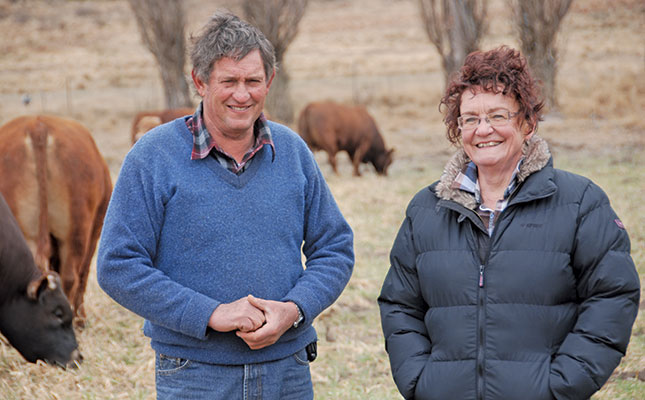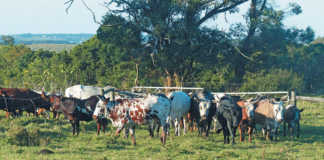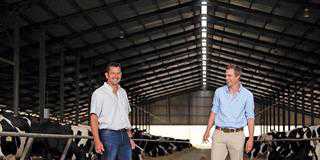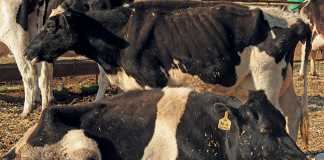
Photo: Heather Dugmore
It’s been a huge challenge but unbelievably rewarding. If I look back on the 24 years of breeding and selection to get my cattle where they are today, the only thing that saddens me is that I’m not 24 years younger,” says Dries, who established his Ivukile Beefmaster Stud in 1988.
He wipes his brow as he brands the last of a group of heifers on an icy early September day on his farm Leliekloof between Burgersdorp and Jamestown in the Eastern Cape. Winter temperatures here often plummet below -15°C. It is spring and the warmer season has not yet found its way to this remote mountain hideaway, where humans and cattle have to be hardy to survive.
“I remember one particularly cold night in July a few years ago when we recorded -19°C in the sheltered environment of the farm house,” Dries recalls. “A group of heifers slept in a vlei where the temperature would have been even lower. Their tails and ears froze and a month later, started falling off. You can still see some of them in our herd today with no ears and a quarter of their tails!”
The beginning
Dries’s family has been farming in the Stormberg since his namesake grandfather Andries Cornelis de Klerk’s time. Andries Cornelis was an orphan and adopted by the De Bruin family in the Burgersdorp district. A plucky, entrepreneurial soul, at the age of 14 he borrowed money from his father to buy a span of oxen and a wagon. He then established a business transporting produce for the Stormberg farmers between Burgersdorp, Molteno and Jamestown.
Four years later, he bought his own land, the farm Wonderpoort, and started farming Merinos, Friesland cattle and potatoes. Today, Dries and Minnie farm on approximately 5 000ha in the Stormberg and Aliwal North districts, a combination of owned and leased land that includes 200ha rainfed lucerne and 9ha purple-top turnips and oats. The farms are subdivided into camps averaging 18ha, except for the mountain winter camps, which average 80ha. While many farmers shy away from the higher-lying areas in the winter, Dries and Minnie use them well.
“The kloofs offer shelter, and the most important factor here in winter is shelter,” Dries explains. This year’s annual Ivukile bull sale demonstrated just how well the cattle are doing. A total of 34 bulls were auctioned – 28 Beefmaster bulls and six Boran bulls. Most were three years old while some were two, and there was a combination of registered and commercial animals. All the animals were sold, with the average price for three-year-old Beefmaster bulls at R30 850.
Selection
Before each year’s auction, the bulls are given a reprieve from the harsh winter veld. Leliekloof has a mix of sweet and sour grasses but at this time of year, they offer negligible nutritional value. “We take them off the veld and round them off on turnip and oats lands for three months before the auction to achieve weights of about 900kg,” Dries explains.
The bulls gain 150kg during this period, and while they lose some of this excess weight when put back in the veld, they hold their condition well because of the rigorous selection process. Bulls are selected for breeding potential at 205 days when they weigh between 275kg and 315kg. After two winters and two summers on the veld, supplemented with only a Dundee maintenance lick, the pick of the crop are selected for the auction.
“Nature in this high berg veld selects only animals with the genetic potential to utilise the low nutritional value of the grass in winter and the short, four-month growing season,” Dries says. “The genetic makeup enables them to handle these conditions. Working with nature reveals the best type of animal over time.”
He refers to the legendary American founder of the Beefmaster breed, Tom Lasater, who emphasised that form follows function. Lasater based his selection on six essentials: weight, conformation, milking ability, fertility, hardiness and disposition.
“He didn’t worry about whether a cow had a bit of colour in her hide from her Hereford genetics or about her height. What he looked for was a highly efficient, hardy animal,” says Dries. “My cows today, for example, weigh on average 450kg, around 100kg less than my pre-Beefmaster herd. The cows that I now have perform best under the selection pressure of this high-altitude, mountainous terrain. The bigger the body the more energy it needs.”
Dries believes that breeders do not apply the necessary selection pressure on all their animals. “They bandy about calving rates of 95% plus, but their cows are fed winter and summer. How can a breeder identify his weaker and less fertile animals under these conditions?”
Love for Beefmaster
Dries’s relationship with the Beefmaster breed goes back to 1981 when he took over a Hereford crossbred herd from his father, who had put Santa Gertrudis bulls onto the Hereford cows to add smoothness of skin and darker pigmentation.
“When the breed was established in South Africa in the mid-80s, I liked the look of the animal and I identified with the common sense of the Lasater philosophy,” he explains. Interestingly, Prof Jan Bonsma, who developed the Bonsmara breed, is said to have described the Lasater Beefmaster herd as “near perfection in functional efficiency”. “I decided to start farming them after visiting Beefmaster breeder Trevor Stretton of Sterkstroom and bought my first Beefmaster bull in 1987,” Dries recalls. “It was serendipitous that the composition of my cow herd at the time was essentially Beefmaster.”
Dries registered his stud a year later, and today he and Minnie breed an outstanding combination of registered and commercial bulls, all subject to exactly the same rigorous performance tests. They also have a Droughtmaster line, started in 2001 when they bought a bull from Graham Hart of Komga, whom Dries describes as “a good friend and exceptional cattleman”.
The bull – GH 99 0045 – son of the Droughtmaster bull Wingfield Rocket from Australia, was mated to one of Dries’s top Beefmaster cows. Her son, FCK 04 0072, became an outstanding stud sire in the couple’s herd, establishing their Valley Droughtmaster line. “Droughtmasters are the Australian counterparts of Beefmasters, which originate in the USA,” Dries says.
Natural selection
His 400 breeding cows are subject to the same rigorous selection criteria as his bulls. Following Lasater’s Cow Power philosophy, Dries explains that the cow is genetically and economically the basis of cattle farming, and he places significant emphasis on quality and performance. In winter, the cattle are run in herds of 70 to 90 cows, and in summer in single sire breeding herds of 30.
The mating season is limited to 90 days in a drought-stricken year, and 70 to 80 days in good rainfall years. Heifers are put to the bull on 20 November, two weeks earlier than the cows. These first calvers get no special treatment“They get good grazing and run in their own group with a phosphate lick (two bags salt to one bag P12) in summer when the grass is green, as do the cows. This way, we apply selection pressure on the first calvers and identify any weakness early on,” he explains.
In winter, all the cows get a Dundee maintenance lick – the Dundee lick and salt, without any maize – 400g to 600g per cow daily. Ahead of the calving season in August and September, energy in the form of molasses (16% of the lick) is supplied. The heifers calve from 20 August and the cows from mid-September. One month before calving, the cows and heifers receive a Vitamin A injection and in early December, just before the mating season, a Multimin injection. “Every cow must calve and wean a quality calf every year, without assistance, in season, on natural veld,” says Dries.
He annually selects 120 heifers out of about 200 as breeding stock. All bull or heifer weaners not selected, as well as culled cows, are sent for slaughter. “As breeders, we maintain the strictest standards because these are the genetics we are selling to our buyers. A commercial cattleman doesn’t need to be so strict and could provide a lick with higher levels of protein and maize to enable pregnant animals to achieve maximum economic production under harsh conditions. He can also use a longer mating season on condition the bulls he buys in have been strictly selected.”
Performance
“Even in the toughest of times we expect our cows to perform,” says Dries. “We strive to maintain a calf-to-dam weaning weight ratio of at least 50%. Many cows wean calves at 60% and above of their own body weight.”
Amongst his cows is an 11-year-old Elite Gold in admirable condition. The Elite Gold standard is an award given by SA Studbook to cows that perform exceptionally throughout their lifetime – for example, if they calve every year, and their calves are of outstanding quality and kept in the herd as breeding stock or sold as stud bulls.
“Cows are retained for as long as possible in our herd as they carry the genetics of longevity and have survived everything that nature has thrown at them,” says Dries. Hopefully this will be a good year on Leliekloof, which receives an annual rainfall of 550mm. Over the past six years, the farm has not had spring rain, the first falling in late November and into December. Perhaps this year will be different; by the time you read this, the rains will have come.
Phone Dries and Minnie de Klerk on 087 550 0589, email [email protected] or visit www.leliekloof.co.za.













